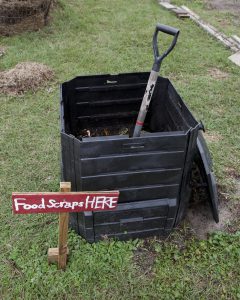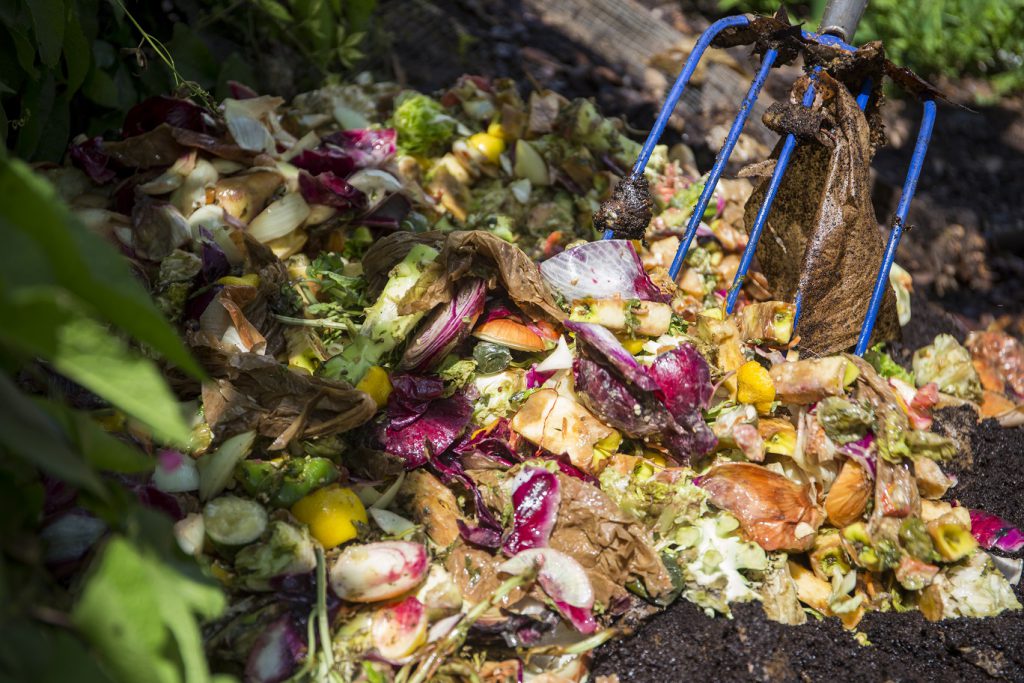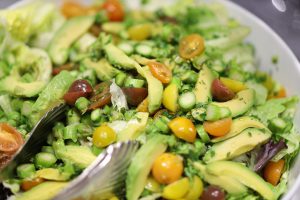
by Samantha Kennedy | May 13, 2021

Samantha Kennedy, FCS Agent
(Source: Samantha Kennedy)
Samantha Kennedy is the Family and Consumer Sciences Agent in Wakulla County, FL. She specializes in health and wellness programming – healthy cooking, nutrition, and food safety – and is working to expand her expertise in financial education by studying to become an Accredited Financial Counselor (AFC).
Samantha – Sam, to her friends and family – received two degrees from the University of Florida (Go Gators!): a B.S. in both Microbiology and Cell Science and Nutritional Sciences in 2000 and an M.S. in Agricultural Education and Communication in 2002. With the exception of a couple of years right after grad school, Sam has proudly been a student at or faculty member of UF for nearly 25 years.
Sam began her Extension career in 2004 as the Family and Consumer Sciences Agent in Manatee County, FL, where she specialized in nutrition, chronic disease management, food safety, and home energy efficiency. In 2013, she became the County Extension Director in Manatee County and served in that role until November 2016, when she left southwest Florida for the beautiful Florida Panhandle.

Sam loves baseball. So far she has visited more than 20 major league ballparks. Visiting all 30 is definitely on her bucket list. (Source: Samantha Kennedy)
Hands-on teaching and live demonstrations are Sam’s favorite part of being an Extension Agent. She loves interacting with clientele and teaching them new skills while having fun. The Kitchen Creations day camp she holds each summer has been a great success. Seeing the kids engaged and excited about cooking and providing them with skills they will use for the rest of their lives is very rewarding.
Other Family and Consumer Sciences programming that Sam has been involved with over the years includes: Keeping the Pressure Down, Take Charge of Your Diabetes, Let’s Walk Florida, Walk Across Wakulla, Cooking with Herbs, Cheese Making, Home Canning, One-Pot Meals, The Art of Air Frying, Volunteer Income Tax Assistance, and the Manatee Energy Efficiency Project, just to name a few.
Sam was born in central Michigan, but moved with her family to south Florida when she was four, after her dad decided he was never shoveling snow ever again. When she was around seven years old, her family moved to west Arkansas (where it snows, yes, but not like Michigan), where they lived for about two years before heading back to Florida for good (well, sort of). She spent the rest of her childhood and adolescence in Deerfield Beach, FL and graduated from Deerfield Beach High School in 1995 (Go Bucks!).

Sam works to keep her cats in the lifestyle to which they have become accustomed. Clockwise from top left: Wesley (aka “Old Man”), Simon (aka “Mr. McNaughty Pants”), Lucas (aka “Squooshy,” may he rest in peace), and Porter (aka “Floofmaster P”).
(Source: Samantha Kennedy)
After graduate school, Sam moved to Katy, Texas and lived with her brother and his family for nearly two years, until she applied for and was hired for the Family and Consumer Sciences Agent position in Manatee County. Boy, was she glad to be back in Florida! Sam has lived all over the state: north central, south, southwest, and now northwest, but there is still a lot of this beautiful state she has left to see (e.g. she has never been to the Keys, if you can believe that!).
Sam’s cats (“the boys”) are the best cats in the entire universe (though she may be a bit biased). She likes to joke she runs a retirement home for cats, since they range in age from 13 to nearly 21 years old, but she would not trade a moment of it. When she is not working to support her feline family, she enjoys reading for pleasure, taking walks, journaling, hand lettering, and napping. Sam is also a huge baseball fan (Go Rays!), and has visited over 20 major league ballparks with plans to visit all 30 before the zombie apocalypse comes.

by Samantha Kennedy | May 13, 2021
I would like to continue on the theme of reducing food waste by talking more specifically about ways to use food scraps effectively to prevent them from ending up in the landfill.
As I was thinking about this topic, I was reminded of a funny scene from the 1982 film Night Shift, where Michael Keaton’s character, Billy Blaze, says into his tape recorder, “Idea to eliminate garbage: edible paper. You see, you eat it, it’s gone. Eat it, it’s out of there. No garbage.” Think about how much less waste would go into our landfills if we could just eat paper!
It is the same concept for food waste. As much as 40% of food grown, processed, and transported in the United States will never be eaten, destined to end up in the landfill. That is literally thousands of tons of food wasted each year. But what if we could help reduce that amount?

Got leftover veggie scraps? Instead of throwing them away, save them for a delicious veggie soup.
(Photo source: UF/IFAS)
Here are two great ideas for using leftover food scraps instead of throwing them away.
Cook with them. Leftover vegetables are great ingredients for a simple and delicious soup. Simply take the leftovers, combine them with an aromatic base of onions, garlic, and celery, add a liquid such as stock or broth (or water and white wine), throw in a generous helping of herbs, and cook for about 25-30 minutes. Then use an immersion blender or food processor (or stand-up blender) to blend into a creamy soup. Any type of vegetable works for this type of soup, from greens and cauliflower to parsnips and sweet potatoes, which makes it an ideal way to use up those scraps.
Another great way to use vegetable scraps is to make homemade stock. Vegetable parts such as carrot ends and peels, celery ends and greens, corn cobs, pea pods, and all the other bits trimmed off during food preparation can be used to make stock. Not in the mood to make stock right away? No problem! Veggie scraps can be saved in a zippered bag and kept frozen for up to six months.
When the time comes, simply dump the scraps into a large stock pot (that is why it is called a stock pot!) or Dutch oven, fill the pot 3/4 of the way with water, bring to a boil and simmer for at least 30 minutes. (The longer it simmers, the richer the flavor.) Strain it all through a sieve. The remaining liquid is the stock. Fresh stock can be stored 3-5 days in the refrigerator or frozen up to three months. Here is a simple resource from Cornell University Extension on how to make vegetable stock from kitchen scraps. (Here is another one from Tasty.co.)
Hold on! There are still scraps left over. What about those? Well, that brings me to the second great way to use kitchen scraps.

Food waste such as vegetable scraps can be added to compost to create a nutrient-rich fertilizer for home gardens.
(Photo source: Tyler Jones, UF/IFAS)
Compost them. Creating compost at home takes a little work and perseverance, but it can certainly pay off in the home garden. Nutrient-rich compost can add oomph to flower beds and vegetable patches and turn any garden into a showcase.
Vegetable scraps are perfect additions to any compost pile. Any vegetable scraps can be added to compost. Just remember to remove the little stickers, as those are not compostable.
According to the Environmental Protection Agency (EPA), there are many benefits to compost. It enriches soil, helping retain moisture and suppress plant diseases and pests. It reduces the need for chemical fertilizers. And it encourages the production of beneficial bacteria and fungi that break down organic matter to create humus, a rich nutrient-filled material. These fact sheets (this one and this one) from UF/IFAS Extension are a wealth of information about home composting.
The reduction of unnecessary food waste begins with us, the consumers. By learning how to use those scraps in useful ways, such as cooking and composting, we can help eliminate the excess food waste filling our landfills.
UF/IFAS is an Equal Opportunity Institution.

by Samantha Kennedy | Mar 17, 2021
Food waste is a huge problem here in the United States. Here are a few incredible facts: Food is the most common solid source of waste in American landfills. Anywhere from 25-40% of food grown, processed, and transported in the US will never be eaten. Food waste harms the environment and results in a lot of wasted money.
Looking for ways to reduce food waste? Just follow these six tips.
Plan meals carefully. Only purchase what will be eaten in a reasonable amount of time, especially perishable items. Buying large quantities of fresh produce, dairy, and other perishables may seem like a time-saving practice. However, throwing spoiled food away not only wastes money, but also time, since the spoiled items need to be replaced during another trip to the market.

Instead of throwing old fruits and vegetables away, turn them into nutrient-rich compost to help your garden thrive. (Photo source: Camila Guillen, UF/IFAS)
Freeze or re-use food whenever possible. Not all food freezes well. However, fresh fruits and vegetables freeze quickly and easily when handled properly and can last in the freezer for months. Vegetable scraps are also great for making compost, which enriches the soil and can help support the growth of backyard gardens.
Look at the sell by/use by/best by dates on food products. Try to purchase items with the longest shelf-life (the latest date) available. If a product is close to its sell by date, be sure to use it or freeze it quickly. Keep in mind, however, that just because a product is past its use by date does not mean it is unsafe to eat. Take it on a case-by-case basis. If there is no mold, pests, off odors, off colors, or off textures, the product is safe to consume. This is especially true for dry, non-perishable items.
Store food properly. Storing foods at the wrong temperatures can speed up the spoilage process. Keep the refrigerator between 37 and 39 degrees Fahrenheit. Dry goods storage should ideally be around 50 degrees F, but since this is not realistic for most of us, just make sure dry goods are stored in a cool, dry place outside of direct sunlight.
Stay organized. Arrange items so that the oldest stuff is in front. This helps ensure it is used first. Always label frozen foods with the item name and date it was first frozen and use within 12 months whenever possible. Foods frozen for longer than a year start to diminish in flavor and texture. Old food also tends to attract pests, so making sure things are used efficiently can help eliminate the risk of insects and rodents.
Donate non-perishables to those in need. Food banks and other community organizations are always looking for food donations to help the hungry. Non-perishable foods that have not surpassed their use by/sell by dates are always welcome donations. Instead of trashing it, share it with someone less fortunate.
In most cases, food affected by flood damage or other disasters should be discarded for safety reasons. Better to be safe than sorry. However, everyday food waste is completely avoidable if a few simple rules are followed. The amount of food thrown away each year in the US is disheartening. When shopping, being a little more mindful of quantities and dates can help reduce overall food waste, saving both money and the environment.
Additional Resources:
National Center for Home Food Preservation (University of Georgia Extension)
Food Waste Resources (Kansas State University Extension)
UF/IFAS is an Equal Opportunity Institution.

by Samantha Kennedy | Jan 14, 2021
Guess what, guys? We made it! We have finally put 2020 behind us and are now looking forward to 2021. I, for one, am hopeful. I am expecting great things from this year.
Admittedly, I have not always had an optimistic outlook. I used to like to say that I was a natural-born cynic. And while I still have cynical tendencies, I have learned strategies over this last challenging year that have really helped me look at things more positively and helped me deal with stress.
It all starts with mindfulness. While this has really become a bit of a buzzword in recent times, the foundations of mindfulness are solid and based on research. At its most basic, mindfulness refers to the practice of being in the moment. Sounds simple, right? Well, if your mental habits are as ingrained as mine were, it takes a lot of practice to be in the moment.
I am an overthinker. A brooder. A ruminator. As far back as I can remember, I have thought about things before I did them, then thought about them again for a long time afterwards. Especially if it was something I felt I had not done right or that did not go well. I would be driving or trying to sleep and thoughts, regrets, and recriminations would just be spinning, spinning, spinning endlessly in my head.

Spending time in a peaceful place without outside distractions is a great way to refresh and recharge. (Photo source: Marisol Amador, UF/IFAS)
This was just who I was. I had learned to live with it. I always knew that if something important was coming up, like an exam or a presentation, I would obsess about it beforehand to the point where I would lose sleep. If something happened that did not go well, I would fixate on it for days afterward.
It was stressful, but I dealt with it. And then 2020 happened.
Suddenly, I could not deal with it anymore. My obsessive ruminations and self-recriminations were suddenly unmanageable in the midst of the social isolation and worries brought on by the strains of a global pandemic.
I needed to find a way to change my outlook. A way to deal effectively with the overwhelming feelings I was experiencing. I wanted to be more positive. I wanted to stop seeing doom over every horizon. Most of all, I wanted to stop obsessing about everything all the time.
So I started reading about mindfulness. Then I started trying to practice it. I say “trying” because there are still days where I am just not feeling it, where I am just not able to find that quiet space inside myself that I need to tap into to be in the moment. However, I have gotten better at it with practice.
The key is breathing. Focusing on my breath – each inhale and each exhale, one after the other – allows me to feel centered, to relegate my other thoughts to the background. When outside thoughts arise, I have learned how to push them away and concentrate on the moment. And the next one. And so on.
The best part about this practice is how portable it is. No matter where I am, I always have my breath. If I am feeling overwhelmed or angry or sad or frustrated, I can simply take a few moments to concentrate on my breathing, allowing those feelings to just be, and, eventually, they pass, leaving me feeling refreshed.
I encourage all of you to take on 2021 with a mind towards mindfulness. You may be surprised at just how much a few minutes of purposeful breathing each day can improve your overall outlook. It has really changed my life.
For more information about mindfulness, check out the UF/IFAS Extension fact sheet Mindfulness: An Introduction.
UF/IFAS is an Equal Opportunity Institution.

by Samantha Kennedy | Nov 10, 2020
It has often felt like time has dragged on in 2020, but despite all the challenges, time has continued to march on, and that means the holiday season is right around the corner. Thanksgiving is fast approaching; November 26th will be here before we know it. And while this year has been tough in many ways, we also have a lot for which to be thankful.
One of the ways we celebrate that gratitude is through a nice meal with friends and family. However, many of us have experienced financial difficulties over the last several months, which may put a damper on our traditional celebrations.
With that in mind, here are a few tips for saving money this Thanksgiving:

Keeping the sides simple and having guests contribute items to the meal are two ways to reduce the overall cost of a Thanksgiving meal. (Photo source: Tyler Jones, UF/IFAS)
Shop with a list. This is good advice for everyday shopping, too, but especially at the holidays, when there are just so many delicious seasonal goodies available and we might feel like splurging. Don’t get carried away, though! Stick to traditional favorites everyone enjoys and only get enough to feed the number of guests, not an army. And remember, if it’s not on the list, don’t buy it.
Shop early. Supermarkets often begin putting holiday food items on sale weeks before the main event. Planning ahead and purchasing ingredients early can save money in the long run. Also, think about purchasing canned and dry goods for next year’s festivities right after this Thanksgiving, as ingredient prices are reduced in order to sell them more quickly and make room for other items. Just remember to check the expiration/sell-by dates to make sure they do not expire before next year.
Choose one type of meat. Turkey is the traditional centerpiece to most American Thanksgiving meals, but it doesn’t have to be. Other popular meats include ham, lamb, roast, and prime rib. The key to saving money on the meat, however, is to choose just one. Meat is one of the most expensive items on a Thanksgiving menu, and, odds are, if there is an abundance of side dishes, there won’t be a need for as much meat.
Frozen over fresh. As for the turkey, go with a frozen store brand turkey. The savings could be significant over a name brand or fresh turkey. Just remember, frozen turkeys take time to thaw safely in the refrigerator. Plan for 24 hours of thawing time per five pounds of turkey. For example, a 15-pound turkey will take at least three days to thaw in the refrigerator. Remember to place the turkey in a pan to prevent juices from dripping onto other food in the refrigerator.
Make it a potluck. Ask guests to bring a dish to share with everyone else. This way, the expense is spread out over several people and everyone saves money. There are some really great free websites that allow people to sign up to bring certain items. Customizing the sign-up helps ensure that everything is accounted for and that there isn’t a pile of pumpkin pies but no side dishes.
For more information about holiday savings tips, contact Samantha Kennedy, Family and Consumer Sciences agent, at (850) 926-3931, or reach out to your local Extension office.
Additional Resources:
Five Steps to Seasonal Savings (UF/IFAS Extension)
Food Safety Tips for the Holiday Season (UF/IFAS Extension)
UF/IFAS is an Equal Opportunity Institution.












